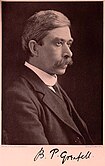Papyrus 22
In this article we are going to address the topic of Papyrus 22 from different perspectives, with the aim of delving into its importance and relevance today. Papyrus 22 is a topic that has generated great interest in different areas, since its influence extends to numerous areas of society. Throughout this article, we will analyze the different facets of Papyrus 22, exploring its impact on everyday life, its evolution over time, and possible future implications. In addition, we will examine the opinions and reflections of experts in the field, as well as the experiences of people who have closely experienced the influence of Papyrus 22 in their lives. In short, this article aims to offer a deep and complete vision of Papyrus 22, in order to enrich knowledge and understanding of this exciting topic.
| New Testament manuscript | |
 | |
| Name | P. Oxy. 1228 |
|---|---|
| Text | John 15-16 † |
| Date | 3rd century |
| Script | Greek |
| Found | Egypt |
| Now at | Glasgow University Library |
| Cite | B. P. Grenfell & A. S. Hunt, Oxyrynchus Papyri’' X, (London 1914), pp. 14-16 |
| Size | 18.5 x 5 cm |
| Type | Alexandrian text-type |
| Category | I |
Papyrus 22, designated by 𝔓22 (in the Gregory-Aland numbering of New Testament manuscripts), is an early copy of the New Testament in Greek. It is a papyrus manuscript of the Gospel of John, only containing extant John 15:25-16:2, 21–32. Using the study of comparative writings styles, (palaeography), the manuscript has been dated to the early 3rd century CE. It is the only identified New Testament papyrus to have been written originally as a roll; not a codex or re-using the back of a scroll.
Description
The text was written in two consecutive columns on a roll. The reverse side is blank. The manuscript employs conventional Nomina Sacra: ΠΣ ΠΝΑ ΠΡΣ ΠΡΑ ΙΗΣ ΑΝΟΣ. The text contains no punctuation marks.
The Greek text of this codex is considered a representative of the Alexandrian text-type. Aland described it as a normal text and placed it in Category I. This manuscript displays an independent text. Coincidences with the Codex Sinaiticus are frequent, but divergences are noticeable. There are no singular readings. According to Schofield the fragment rather represents the eclecticism of the early papyri before the crystallizing of the textual families had taken place.
It is currently housed at the Glasgow University Library (MS Gen 1026) in Glasgow.
See also
References
- ^ a b c Aland, Kurt; Aland, Barbara (1995). The Text of the New Testament: An Introduction to the Critical Editions and to the Theory and Practice of Modern Textual Criticism. Erroll F. Rhodes (trans.). Grand Rapids: William B. Eerdmans Publishing Company. p. 97. ISBN 978-0-8028-4098-1.
- ^ a b c Comfort, Philip Wesley; David P. Barrett (2001). The Text of the Earliest New Testament Greek Manuscripts. Wheaton, Illinois: Tyndale House Publishers. p. 109. ISBN 978-0-8423-5265-9.
- ^ a b B. P. Grenfell & A. S. Hunt, Oxyrynchus Papyri X, (London 1914), p. 14.
- ^ Peter M. Head, The Habits of New Testament Copyists Singular Readings in the Early Fragmentary Papyri of John, Biblica 85 (2004), 406.
- ^ "Liste Handschriften". Münster: Institute for New Testament Textual Research. Retrieved 23 August 2011.
Further reading
- B. P. Grenfell & A. S. Hunt, Oxyrynchus Papyri X, (London 1914), pp. 14–16.

